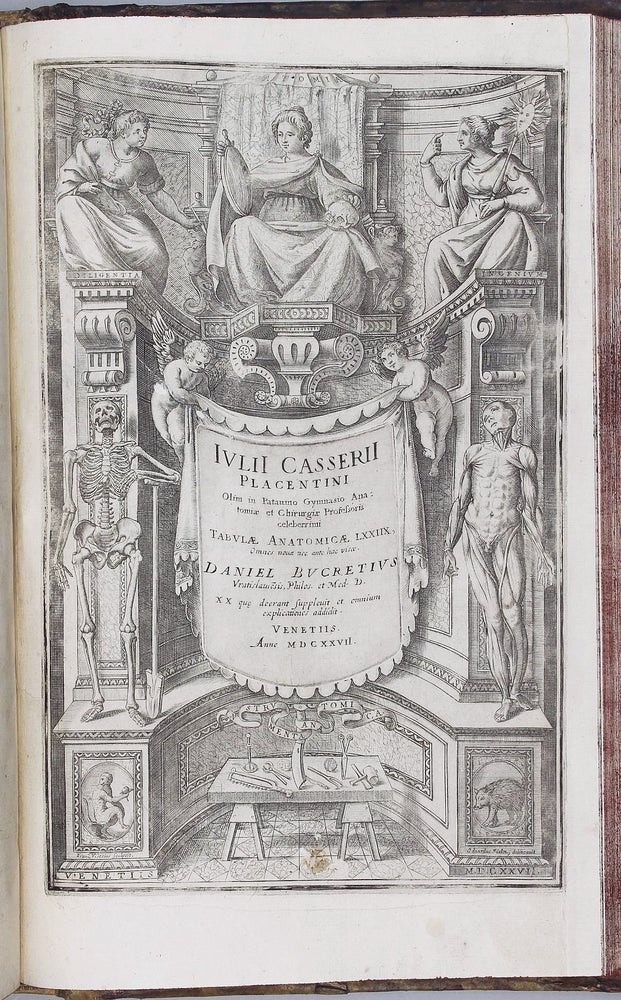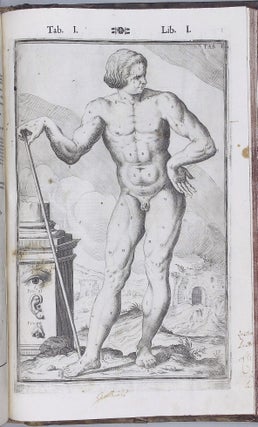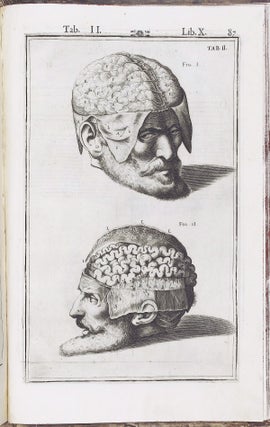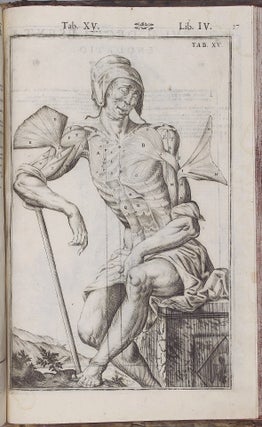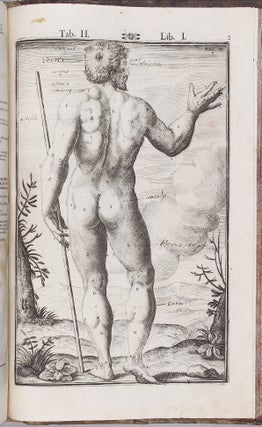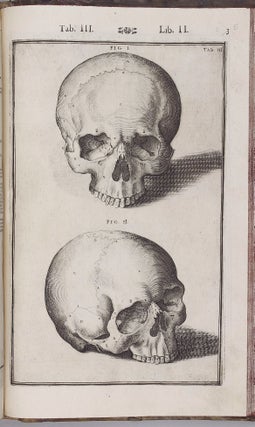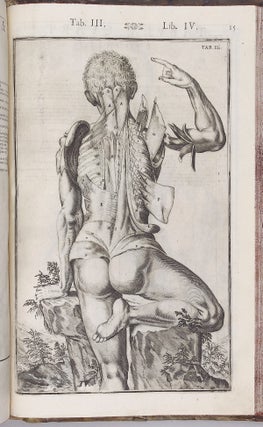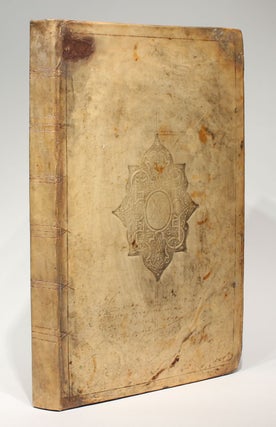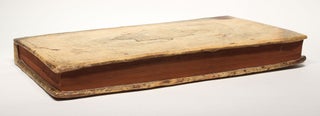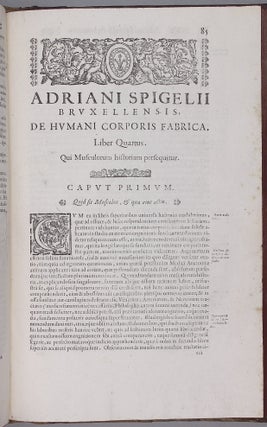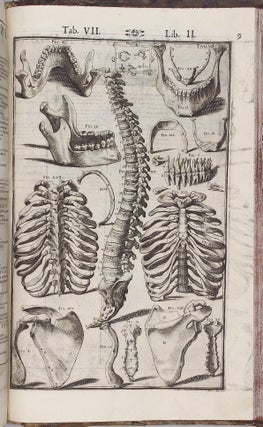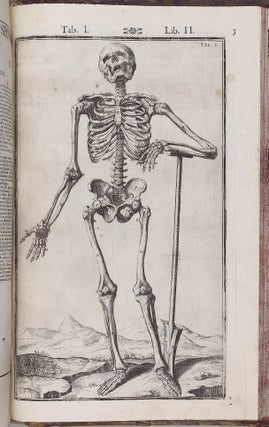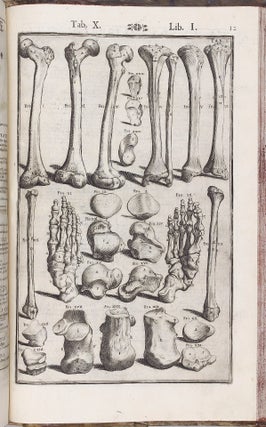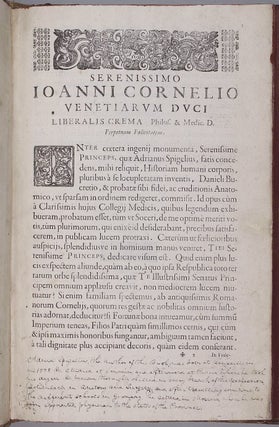The first original anatomical illustrations since Vesalius
Tabulae Anatomicae LXXIIX . . . Daniel Bucretius . . . XX que deerant supplevit et omnium explications addidit.
Venice: [Evangelista Deuchinus], 1627.
1st Edition. Hardcover. Very Good. Item #002279
Tabulae Anatomicae LXXIIX ... Daniel Bucretius ... XX que deerant supplevit et omnium explications addidit. Venice: [Evangelista Deuchinus], 1627. [3], 1-87, 87-88, 88-95 ff, including engraved title with border by Valesio after Fialetti, 97 full-page engravings numbered to 95 (77 probably by and after J. Maurer, 20 by Valesio after Fialetti), explanatory text on verso, woodcut ornaments, colophon and printer's woodcut device on final leaf verso. [Bound before:] SPIEGEL, Adriaan van de [SPIGELIUS, Adrian]. De humani corporis fabrica libri decem... [12], 328 (i.e. 330), [14] pp., including engraved title with architectural border by Valesio after Fialetti, woodcut initials and ornaments, index and final blank. Folio (399 x 255 mm). Contemporary vellum with blind-stamped central arabesque to both boards, binding restored with the spine rebacked (boards soiled and darkened, original endpapers repaired), colored edges. Final leaves of index of De humani corporis with ink smudges (having created 3 holes with loss of letters due to ink corrosion). Internally very little marginal browning, very minor spotting and finger soiling in places, a few faint dampstains, a few closed worm holes in blank margins, frayed engraved title-page of the Tabulae repaired at blank fore-margin, upper corner of fol. 51 with paper repair (not affecting image), a few leaves with faint marginal waterstains, a few closed tears, fol. 1 with marginals in contemporary hand (cropped), plate V in fol. 7 printed upside-down, offsetting to a few plates. Both works carefully cleaned. Extensive annotations to first preliminary leaves, ink stamps by W. W. Hall to a few leaves. Provenances: Samuel Simmons, Maryland (inscribed and dated 1772 on rear pastedown), William Whitty Hall, M.D., physician and editor of health magazines (ink stamp to title page and annotation on two leaves). A handsome copy. ----
Roberts & Tomlinson, The Fabric of the Body, pp. 262-63; see also pp. 259-61; Cazort, Kornell, Roberts, The Ingenious Machine of Nature: Four Centuries of Art and Anatomy (1996) pp. 167-68; Choulant-Frank 225; Garrison-Morton 381; Eimas, Heirs of Hippocrates 414; NLM/Krivatsy 2202; Sappol, Dream Anatomy, pp. 110-111, 113; Waller 9121 and 1812.
FIRST EDITION OF THIS MAGNIFICENT AND ORIGINAL SERIES OF ANATOMICAL PLATES drawn by the late-Mannerist Italian painter and printmaker, Odoardo Fialetti (1573-1638) and engraved by Francesco Valesio (b. ca. 1560). Born in Bologna, Fialetti initially apprenticed with Giovanni Battista Cremonini, and later under Tintoretto, with whom he was a favorite. Fialetti painted some of the churches at Venice, where he settled in 1604 in preference to Bologna, in order to avoid competition from the Carracci. Fialetti also engraved many plates, and was the author of works on costume, the arts, and a treatise on anatomy for artists. Since before 1600 Casseri had been working on a fully-illustrated anatomical treatise, which he hired Fialetti to illustrate. His De Vocis of 1601 concludes with a promise to publish a treatise on the anatomy of the whole human body with illustrations. However, at the time of his early death in 1616 Casseri left 86 spectacular anatomical drawings by Fialetti, and also possibly their engravings, but no text. Casseri and the co-author of this work, Adrian van de Spiegel, both studied under Fabrici (Fabricius ab Aquapendente) at the University of Padua. Both worked closely with their teacher for many years, and in 1608 Casseri succeeded Fabrici in Padua's chair of surgery and anatomy, which passed in turn to Spiegel upon Casseri's death in 1616.
Spiegel (Spigelius) (1578-1625) wrote an unillustrated treatise on anatomy that remained unpublished during his lifetime; in his will he appointed Daniel Bucretius (latin for Rindfleisch) to see the work into print. To illustrate Spiegel's treatise, Bucretius obtained 77 of Fialetti's original 86 anatomical plates from his Casseri heirs, and commissioned 20 more by Fialetti and Valesio to complete the series (the remaining 9 plates left by Casseri were used to illustrate Spiegel's De Formato Foetu [1626], see item #16).
"In the complete series, the largest number of plates, forty-three - and these perhaps the most memorable - are to be found in Liber IV, on the muscles. There are also interesting illustrations on the genito-urinary system in Liber VIII and on the brain in Liber X - one of these, showing the arterial circle at the brain, predates the Willis-Wren illustration [from Willis's Cerebri Anatome (1664)]... Except for those few plates which were derived from Vesalius, the anatomists - Casseri first and Bucretius later - had reconsidered ways of presenting human anatomy. In doing so they produced the first original series of illustrations of the anatomy of the human body since Vesalius, Estienne and Eustachio" (Roberts & Tomlinson, The Fabric of the Body, pp. 262-63; see also pp. 259-61), see also Jeremy Norman, HistoryofScience.com.
Sold
Delivery time up to 10 days. For calculation of the latest delivery date, follow the link: Delivery times
Lieferzeit max. 10 Tage. Zur Berechnung des spätesten Liefertermins siehe hier: Lieferzeiten


